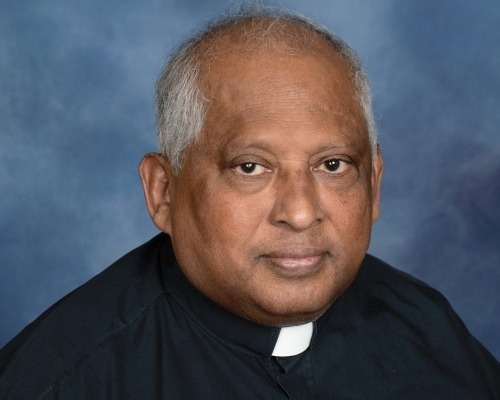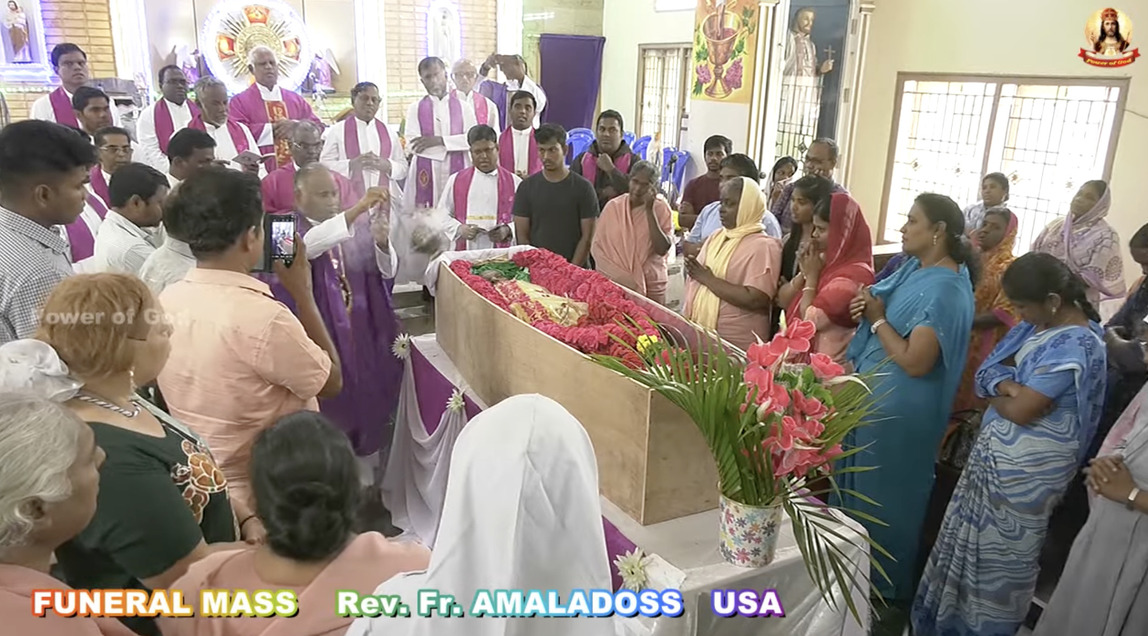
A platform that encourages healthy conversation, spiritual support, growth and fellowship

NOLACatholic Parenting Podcast
A natural progression of our weekly column in the Clarion Herald and blog

The best in Catholic news and inspiration - wherever you are!
Father Amaldoss never stopped dreaming the big dream
-

By Peter Finney Jr.
Clarion Herald
Father G. Amaldoss, who died unexpectedly Jan. 29 while visiting family in India, used to poke fun at his elongated Indian first name, which he said had more letters than Mary Poppins’ “supercalifragilisticexpialidocious.”“Just call me ‘G,’” said the pastor of St. Joachim Parish in Marrero, who was beloved by parishioners for his nonstop dreams of improving what he affectionately called “The Little Church in the Woods.”
Father Amaldoss, 76, died in India apparently as a result of respiratory problems, said St. Joachim sacramental assistant Elena Graf-Gonzalez.
Father Amaldoss was not feeling well when he left in early January on his annual, one-month trip to India, where he would visit relatives and bless the small homes and the wells he had built for the poor with donations he had solicited.
“He wasn't feeling too well when he left, but he went,” Graf-Gonzalez said. “He had gone to the doctor and gotten antibiotics, but it seems like something happened to him over there. He had a really bad cough, and then he wasn't able to answer people's phone calls because he couldn't talk long enough without coughing.”

Father Almadoss’ Funeral Mass was celebrated Jan. 31 at Vailankanni Shrine Basilica in southern India. He was buried next to his parents. A Memorial Mass for Father Amaldoss will be celebrated Feb. 8 at 6 p.m. at St. Joachim Church, 5505 Barataria Blvd., Marrero.Father Amaldoss was one of 10 children, four of whom died during a famine. Another sibling drowned. His sister Elizabeth often visited him in Marrero during his 14 years as pastor of St. Joachim.
Father Amaldoss held a doctorate in entomology – the study of insects – and he was fluent in several languages, having served as a missionary and teacher in Taiwan for 16 years at Fu Jen Catholic University in Taiwan.
Father Amaldoss used his knowledge of Mandarin to lead a retreat for Chinese Catholics in 2011. He had picked up the language while at the Fu Jen Catholic University. He discussed the Trinity as a family and how, together, they could share their faith and build a family of worshippers in the Catholic Church.
“When you offer the opportunity to grow in faith at Catholic community gatherings, it gives them encouragement, and their faith will get stronger,” Father Amaldoss said. “Some (new to America) have language difficulties and shy away from larger Catholic Church communities. They are looking for someone who can speak their language. They need a little help in the beginning.”

St. Joachim secretary Andreya Dufree said Father Amaldoss had a way of getting parishioners involved in various ministries simply by inviting them on the spot. During his pastorate, he built an outdoor pavilion for use during large parish fairs, and in 2017 he expanded and restructured the interior of the church to accommodate more parishioners.The glass windows behind the altar looked out onto the wood, giving the church a pastoral feel.
“He was more than a priest; he was like family,” Dufree said. “It was so easy to communicate with him. You know, nobody's perfect, and he would admit his faults. He would say, ‘Sometimes I just want things done, so I don’t have much patience.’”
Father Amaldoss was particularly focused on getting children and teenagers more involved in the life of the church, Dufree said. He instituted a “children’s church” model where the children would leave Mass before the readings and homily to get special instruction on their level and then return for the Eucharist.
“He loved the kids being in church,” Dufree said. “He'd always make sure that if a kid was crying or something, he’d say, ‘Let them cry. Let them run around.’ The kids would run around the altar. He was just like, ‘God loves kids. Let them run around.’”
“The Little Church in the Woods" never really had a church to call its own since it was established in 1985, worshiping in a multi-purpose building amid the cypress trees off Barataria Boulevard.
But Father Amaldoss, pastor since December 2008, continued to dream big for a parish that nearly closed in the post-Katrina restructuring of the Archdiocese of New Orleans. In 2014, he announced that he wanted to build a country church for his growing parish family.
"After 28 years, we need to put roots in the ground," Father Amaldoss told the Clarion Herald in 2014.
In a book about the parish's history – "Quo Vadis: The Little Church in the Woods" – Father Amaldoss said Father Elford Wanke, the founding pastor, always had a vision for a permanent church. He died of diabetes in 1992 at the age of 44.
Father Amaldoss picked up that dream in hopes that the parish's focus on family, children and faith would allow it to realize Father Wanke's original vision. It was not just about building a church but building a community, Father Amaldoss said.
"Everything here is family-based," Father Amaldoss said, noting that his parish has grown from about 300 families to 600 families in the previous three years. "We have no cry room here. We want the children to cry in church. Of course, we don't want any cry-babies."
When the children returned to Mass with the pictures they had drawn of the Gospel story that day, the kids got a chance after Communion to show the adults what they had done.
"The idea is that the whole family is involved," Father Amaldoss said. "We are encouraging families to come together. Sometimes the children will walk around and go to my seat, and they'll tell the other kids to come back on the altar. That's when I tell them to go back and sit down. But the point is, we let the children speak and move. People accept them. The whole church accepts them."
Father Amaldoss said whenever he saw a mother holding her infant or toddler, he immediately thought of the sacrifice she had to make to get her child to Mass.
"First, we are building a community," Father Amaldoss said in 2014. "You need to build the mystical body before you build the church. I always tell the people, give whatever you can give. You are coming to church to worship God. By giving them something that is foundational to life, the money will come later on. We need to let them learn to love God."
Graf-Gonzalez said Father Amaldoss was working on another dream before he left for India.
“He wanted to build a daycare center for the children in the area whose families couldn't afford regular daycare,” she said.
In a reflection on the priesthood for the Clarion Herald last year, Father Amaldoss said he was deeply moved after reading a book by the late Archbishop Fulton Sheen, “The Priest Is Not His Own.”
“It had a powerful impact on me!” he wrote. “This title and the meaning of the words led me to travel far and wide to grasp and understand the true meaning of ‘Not His Own.’ Emptying, dying, giving up, all embracing ‘to become all things to all men’ led me from being on the pedestal on the altar to a traveler walking on the ground in the streets, in the swamp and jungle, countries and cultures, living as a signpost of contradictions in the real world.
“These are the images coming to my mind: Francis of Assisi, Bede Griffith of Thaneerpalli, the Little Flower (St. Teresa of Avila), Oscar Romero, Pope Francis, etc., who constantly challenge my mind and heart with Hamlet’s ‘to be or not to be, that is the question’ in the challenging world!
“Priesthood initially began as thrills and frills and excitements, middle years, breaking down the conventions and concepts in pain and suffocation. It presently exists as a sign and eternal hope of the future amidst the anticlimax of the modern world.”




